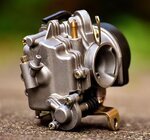Wondering what is the cause of missing in my bike at high speed? Several factors contribute to misfiring in bikes, including a leaking carburetor and bad spark plugs.
Details aside, most people are under the impression that misfiring is hard to repair. But in reality, it’s quite the opposite. Often, you get off by replacing a few bad gaskets. However, in rare instances, you may need to consult a professional.
With that being said, what causes it? And how do you go about fixing misfiring? Here’s all you need to know about misfiring in your bike.
What Is Misfiring?

Before we get into what is the cause of missing in my bike at high speed, we need to understand what misfiring is. Inside your engine, there are a set number of cylinders with pistons inside that can compress air. With the right amount of air and fuel and proper timing, these cylinders can create mini “explosions.” These spurts of energy are then transferred to the wheels via the drivetrain.
Now that’s how a normal engine works. If, say, for any reason, any of the cylinders is unable to combust the fuel, you would have what is called a “misfire.” Misfiring occurs when one of the cylinders doesn’t produce the desired power output or any at all.
Your engine still has the other cylinders to work off of, but the lack of power will be noticeable in many areas.
What Is the Cause of Missing in My Bike At High Speed? Top 5 Reasons:
1. Faulty Carburetor:

If your motorbike has a carburetor, that should be the first thing on your checklist. A carburetor mixes the fuel and the air in the right proportions to be fed into the engine’s combustion chambers.
Often, the incorrect fuel-air mixture can lead to insufficient combustions, resulting in misfiring. So, if you notice your carburetor sputtering constantly, you know it’s your culprit.
Now, your task is to narrow down the problems. There are three most likely issues: a vacuum leak, a gas leak, or a carburetor that needs tuning.
Solution:
Vacuum leaks are often the result of brittle and broken intake boots. These are located near the engine. Another issue could be that your clamp is not tight enough. Depending on the situation, you can replace the intake boots and the clamp.
Unplugged vacuum ports can also cause vacuum leaks. However, you can try re-plugging them or buying new ones as they’re quite inexpensive.
If you notice a strong smell of gas, however, then you have a gas leak. First, take a look at the gaskets and valves. Make sure they’re not cracked or warped. If they are, replace them accordingly. Gaskets near the engine headers and those on the float bowl are the most common culprits.
If none of that works and the carburetor is still sputtering, then you need to tune it. Tuning means adjusting the screws to get the right air-to-fuel ratio. Again, you can do this yourself via consulting the manual or have a professional do it for you.
2. Malfunctioning Spark Plug:

The spark plug is the component of the cylinder that ignites the fuel-air mixture. If the spark plug of a cylinder is faulty, it will result in that cylinder misfiring.
Luckily, spark plugs are quite easy to diagnose. Just the color of the spark plug can tell you a lot about its health. First, remove the spark plugs and inspect them closely. Look for any soot buildup or corrosion anywhere on the plug. Corroded spark plugs will need to be replaced.
Solution:
Next, take a look at the point of contact. If it seems worn down, then you need a new spark plug. After that, inspect the distance between the ground and center electrodes. This gap should be a predefined distance. Again, look at the user manual or search online for the correct distance between your spark plugs. If the gap is narrower or wider than that, replace the plug.
While you’re at it, also inspect the spark plug wires. The wires are what deliver the charge to the spark plug. Bad or corroded wires will result in a lack of power to the plugs. Check for any visible damage to the wires, even cracks, and repair or replace them accordingly.
Another common point of failure is the connection head. If the connection head is threaded, then prolonged use and abuse will lead to corrosion. Remove the connection head and inspect the tread for any wearing or corrosion. You can tell if your spark plug wire is threaded by trying to pull it out. If it’s not able to budge, it’s likely not threaded.
3. A Clogged Air Filter:

What is the cause of missing in my bike at high speed even if my carburetor is in good shape? As it turns out, a clogged air filter also produces the same sputtering problem but will be less noticeable. Air filters are what clean the air of dirt and debris before it enters the carburetor. A clogged filter will mess with the air-to-fuel ratio and cause carburetor sputtering.
Solution:
The first step is to identify the problem. This is pretty easy. Locate the air filter. Usually, it’ll be inside the specially designated air box. If you have a newer model, however, the air filter will likely be on the side of the engine.
Next, shine a light inside and check how dirty the air filter is. If it’s too dirty, it will block healthy airflow to the carburetor.
Now how do you fix the issue? Simple: replace the air filter. They’re cheap and often will benefit from replacement even if you can clean them. If your bike uses more expensive ones, however, you can check online to see if and how they can be cleaned.
As a general note, you should be changing the air filters quite frequently. People often neglect them. And they mistakenly try to retune their carb when it was the air filter that was causing the problem.
4. Timing Issues:
Your engine’s pistons, intake valves, and exhaust valves all run on shafts that are precisely timed. Your bike has to keep each shaft timed perfectly to ensure that the combustion cycle usually continues. With off-timing, however, the valves may overlap, and the piston may not compress in time.
This leads to improper combustion, resulting in the affected cylinder misfiring. Timing issues normally occur in all cylinders at once, so you’ll know immediately if that’s the case. However, certain factors may lead to timing issues in just one cylinder.
Timing issues are often caused by someone meddling with the engine. It’s mostly the result of amateurs trying to rebuild their engine or messing around with the timing belt. Other times, fixing the timing can worsen the problem. If you didn’t ever meddle with the engine, chances are, a previous owner did.
Solution:
The best way to solve timing issues is to have a professional take a look at it. It’s not recommended to take on the task yourself. Timing is key to healthy engine performance. And messing up even in the slightest could prove detrimental.
Plus, your mechanic will correctly diagnose the issue for you. It’s not that easy to know if the timing is off, as there are no significant signs. And while you’re at it, get the other issues fixed too. Let the mechanic inspect the bike to find the real cause of the misfiring.
5. Faulty Ignition Coil:
Much like the spark plugs, the ignition coil is crucial for delivering a solid spark to the engine’s combustion chambers. For those of you who don’t know, the ignition coil converts the battery’s voltage into a suitable sparking voltage. Generally, sparks require thousands of volts of voltage. The ignition coil is what provides that.
As such, a faulty ignition coil will result in too little voltage being passed to the spark plugs. This, in turn, will lead to failed sparking, which will cause one or all the cylinders to misfire.
Solution:
The first thing you must do is identify if the ignition coil is faulty or not. It’s not very easy to diagnose. But if you’ve tried everything else, then it might be the case. However, faulty ignition coils are very rare. And it’s most likely something else that’s causing the problem.
Unfortunately, due to the high voltage they provide, they’re not easy to handle on your own. Therefore, it’s not recommended to take on repairing or even replacing the ignition coil. Instead, have a mechanic inspect the vehicle first and, if they determine the coil to be the issue, ask them to repair or replace it.
They’ll most likely repair it, which may cost a few extra bucks. But it’s better than driving with a misfiring engine.
FAQs
What Is The Most Common Cause Of A Misfire?
The most common cause of a misfire is an improper air-to-fuel ratio (AFR). An AFR that is too low or too high will result in incomplete combustion and a host of other problems. Usually, it’s your carburetor that’s at fault. But your air filters could also cause the issue, as well as exhaust leaks.
Is It Okay to Drive with A Misfire?
No, it’s not safe to drive with a misfire. A misfiring engine has a lower power output than it should have. For example, an engine that uses 4 cylinders with misfiring will lose 25% of its power. And a twin-cylinder engine with one cylinder misfiring will lose 50% of its power. This will lead to long-term issues as well as sputtering and vibrating during the ride. It’s recommended to get the problem fixed as soon as possible.
Can Use A High-Octane Fuel Clean the Carburetor?
No, it won’t. Well, it depends. If your car’s user manual says that you should use high-octane fuel, then you must use it. It may be damaging otherwise. With that being, that’s only for the proper functioning of the engine. It won’t clean out the carburetor.
However, if the manual doesn’t say it and no stickers indicate such either, there’s no use in buying high-octane fuel.
Will A Bad Battery Cause Misfire On A Motorcycle?
Yes, a bad battery will cause misfires on a motorcycle, especially if you tend to drive at lower RPMs. However, it’s very unlikely that the battery will cause only a few cylinders to misfire. Instead, it’s more likely that a bad battery will stall the entire engine. Often, it’s not the battery but the other components such as the ignition coil, spark plugs, and their wires.
Do I Need to Rehaul My Motorcycle Engine To Fix The Missing?
Not necessarily. It depends on what’s causing the issue. Oftentimes, you’ll get off by just replacing or repairing a few components. Even an entire carburetor replacement is still more probable than having to rebuild the entire engine. In extreme cases, however, such as off-timing, you may need to rehaul the engine. Again, it’s best to let a professional do this for you, as doing it yourself will cause more harm than good.
Can A Misfire Go Away on Its Own?
It’s quite unlikely. If the missing was caused by a wire that got misplaced or by environmental conditions, then the problem can go away on its own. However, in most cases, the issue will persist and will require special attention. Moreover, even if it does go away, the situation may come back pretty soon.
What Are the Symptoms of a Misfiring Engine?
A misfiring engine will start to “sputter,” that is, it will start to vibrate violently. This will especially be notable when the engine is idling, known as a “rough” idle. Your vehicle will also lose a portion of its power, resulting in sluggish acceleration, low mileage, and low speed. You may also notice black smoke from the exhaust and odd clunking or sputtering sounds from the engine.
Can Misfire Occur in All Cylinders?
Yes, a misfire can occur in all cylinders. Some misfires have a common cause to each cylinder, such as a bad battery of ignition coil. Others, however, are caused by cylinder-specific problems such as one bad spark plug. But yes, all cylinders can misfire.
Why is My Motorcycle Engine Sputtering?
A constant or even intermittent sputtering sound from the engine is a sign of a misfiring cylinder. The noise will usually be accompanied by aggressive vibrations and black smoke from the exhaust. Your “Check Engine” light, if any, will also most likely turn on. And you will notice a lower power output from your engine.
Conclusion
Misfiring can induce anxiety in a lot of motorcyclists. And rightfully so. If left unattended, it can lead to long-term issues and permanent damage.
So, what is the cause of missing in my bike at high speed? The most common culprit behind missing is a leaking carburetor. The leaks could be anywhere: the valves, the float gaskets, even in the carburetor bowl.
Bad spark plugs, ignition coils, wires, and even a misplaced timing belt can also cause the problem. While repairs can be done for cheap, at times, you may need to consult a professional.


